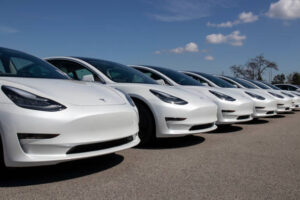Tesla, Nissan, GM Electric Cars Among Those Experiencing Loss of U.S. Tax Credits
Numerous electric vehicles (EVs) have become ineligible for tax credits of up to $7,500 due to new battery sourcing rules that came into effect on Monday.
The affected models include the Nissan Leaf, Tesla Cybertruck All-Wheel Drive, certain Tesla Model 3s, and the Chevrolet Blazer EV, as stated by the U.S. Treasury.
Key Points
New Battery Sourcing Rules Impact EV Tax Credits:
Affecting vehicles like the Nissan Leaf, Tesla Cybertruck, and certain Tesla Model 3s, updated battery sourcing rules have led to the loss of tax credits, reducing the number of eligible EV models from 43 to 19.
Guidelines Aim to Diversify Supply Chain Away from China:
The U.S. Treasury introduced guidelines in December to encourage a shift in the EV supply chain away from China. Effective from Monday, these rules seek to promote domestic sourcing and manufacturing.
Major EV Models No Longer Qualify for Tax Credits:
Prominent electric vehicles, including the Volkswagen ID.4, Tesla Model 3 Rear Wheel Drive, BMW X5 xDrive50e, Audi Q5 PHEV 55, Cadillac Lyriq, and Ford E-Transit, have lost eligibility for U.S. tax credits, impacting the affordability for potential buyers.
Automakers Adapt Supply Chains for Continued Eligibility:
With automakers adjusting supply chains to meet new guidelines, the Treasury notes that these changes are crucial for maintaining eligibility for clean vehicle credits. Partnerships and increased domestic investments are emphasized.
Reform in EV Tax Credit Requirements:
The 2022 Inflation Reduction Act reformed the EV tax credit, mandating vehicles to be assembled in North America to qualify. This reform, aimed at boosting domestic manufacturing, resulted in a significant reduction of eligible models, emphasizing the importance of localized production.

Numerous electric vehicles (EVs) have become ineligible for tax credits of up to $7,500 due to new battery sourcing rules that came into effect on Monday. The affected models include the Nissan Leaf, Tesla Cybertruck All-Wheel Drive, certain Tesla Model 3s, and the Chevrolet Blazer EV, as stated by the U.S. Treasury.
In December, the Treasury released guidelines outlining new battery sourcing requirements with the aim of reducing dependence on China within the U.S. electric vehicle supply chain.
These guidelines came into force on Monday, resulting in a reduction in the number of EV models qualifying for U.S. EV tax credits from 43 to 19.
The figures account for various versions of the same vehicle type. The Treasury noted that some manufacturers are yet to submit information on eligible vehicles, which may lead to changes in the list.
Tesla has not provided an immediate comment, but on its website, it mentioned that the “Cybertruck is likely to qualify for the federal tax credit later in 2024.”

Under the new rules, buyers can claim the tax credit of up to $7,500 at a participating dealership during the point of sale. The tax credit imposes limits on the vehicle price and buyer income to qualify.
Several notable EVs, such as the Volkswagen ID.4, Tesla Model 3 Rear Wheel Drive, BMW X5 xDrive50e, Audi Q5 PHEV 55, Cadillac Lyriq, and Ford E-Transit, no longer qualify for tax credits.
Volkswagen stated on Monday that it is in the process of confirming eligibility for a federal EV tax credit for its vehicles after January 1. BMW did not immediately provide a comment.
Nissan expressed its commitment to working with suppliers to meet changing requirements and regain tax credit eligibility for the Nissan Leaf in the future.
The Treasury emphasized that automakers are adjusting their supply chains to ensure continued eligibility for the new clean vehicle credit, fostering partnerships and bringing jobs and investments back to the United States.
Ford Motor announced last month that its E-Transit, Mach-E, and Lincoln Aviator Grand Touring plug-in hybrid would lose tax credits, but the F-150 EV Lighting and the Lincoln Corsair Grand Touring would retain them. General Motors noted that all its EVs, except the Chevrolet Bolt, would temporarily lose eligibility.
However, it expects the Lyriq and Blazer EV to regain eligibility in early 2024 after a sourcing change. GM specified that its Chevrolet Equinox EV, Chevrolet Silverado EV, GMC Sierra EV, and Cadillac OPTIQ produced after the sourcing change would be eligible for the full incentive.
The 2022 Inflation Reduction Act reformed the EV tax credit, requiring vehicles to be assembled in North America to qualify for any tax credits.
This reform eliminated nearly 70% of eligible models at the time. Tesla disclosed in December that its Model 3 Rear-Wheel Drive and Long Range vehicles would lose federal tax credits starting January 1, while the Model 3 Performance would retain the $7,500 credit.
Lets Conclude
In conclusion, the recent changes in U.S. tax credits for electric vehicles, influenced by new battery sourcing rules, have reshaped the landscape of eligible models. The reduction from 43 to 19 qualifying EVs underscores the government’s push for a diversified supply chain and increased domestic manufacturing.
As major players like Tesla, Nissan, and GM navigate these alterations, the impact on consumer incentives and industry dynamics highlights the ongoing evolution of the electric vehicle sector. With automakers adapting to meet eligibility criteria and anticipation surrounding future developments, the narrative of sustainability, innovation, and regulatory adjustments in the EV industry continues to unfold.
FAQs
Q: Why have electric vehicles lost eligibility for U.S. tax credits?
A: The eligibility changes are a result of new battery sourcing rules implemented by the U.S. Treasury to encourage domestic sourcing within the electric vehicle supply chain.
Q: Which popular electric vehicle models are affected by the loss of tax credits?
A: Notable models such as the Nissan Leaf, Tesla Cybertruck All-Wheel Drive, certain Tesla Model 3s, and the Chevrolet Blazer EV have lost eligibility for U.S. tax credits.
Q: What are the new guidelines introduced by the U.S. Treasury?
A: The guidelines, issued in December, aim to diversify the electric vehicle supply chain away from China. They emphasize increased domestic sourcing and manufacturing.
Q: How has the number of eligible EV models changed?
A: The number of electric vehicle models qualifying for U.S. tax credits has reduced from 43 to 19, reflecting the impact of the new guidelines. Manufacturers may provide additional information, leading to potential changes in the list.
Q: How do these changes affect EV buyers?
A: Buyers of affected electric vehicles will no longer be eligible for U.S. tax credits, impacting the financial incentives previously associated with these models.
For Similar content
-
2025 Cadillac Escalade IQ, with Extreme Luxury and Endless Features
-
Volkswagen Recall Alert: 23,000 Electric Vehicles Affected in the US
-
Nissan Motors gives a additional Hike in Wages after the UAW deal
-
BMW believes 530i beast could be the game changer – Series 5
-
Ford Bronco Sport 2024, Alluring Looks and More
-
Mercedes-Benz Top 5 Fuel Efficient Cars, Saves Some Bucks
-
Electric Cadillac Crossover, GM introduces yet another stylish
-
CEO of BMW USA Foresees Less Sales in Electric Vehicle Sales, Plans to Produce 6 Electric Vehicle Models at Spartanburg Plant.
-
Cadillac VISTIQ EV Model, Officially Announced Arrival In 2026
-
“Mercedes Comeback: James Allison Stresses Mindset as Crucial Factor”- 2023
-
U.S. New Car Sales Next Year Positive Signs: Forecasts Indicate a Marginal Climb 2024
-
Tesla Latest: Meet the New Models Expected in 2024
-
Corvette Mastery: The E-Ray Takes the Lead
-
Chevrolet Traverse Limited 2024 What to Expect ? : A Comprehensive Preview
-
Cadillac Unveils Upgraded CT5 Model in China, Promising a Refreshed Driving Experience


[…] Tesla, Nissan, GM Electric Cars Among Those Experiencing Loss of U.S. Tax Credits […]